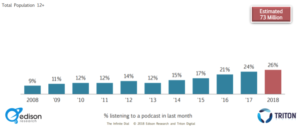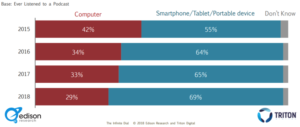Podcasts aren’t necessarily a new form of media, but they have gained significant popularity over the past five years.
As technology has gotten smarter, faster and more connected, podcast content has become a more credible and engaging form of digital audio media. Add to that the recent spike in smart speaker sales and it’s no wonder podcast listenership has increased. It is estimated that 73 million people in the US listened to a podcast in the past month with the majority of them doing so at home. With audiences this large, it should be no surprise that forecasters are expecting podcast advertising to surpass $500 million by 2020.
So, what exactly defines a podcast? A podcast is an on-demand audio show that focuses on a specific topic, for example business, fashion or travel. They can be discovered through publishers like iTunes and Spotify or directly on a host’s website. There are three main ways that individuals are listening to podcasts:
- They’re downloading a full episode onto a device.
- They’re listening to a temporarily downloaded file in a podcast library.
- The podcast is streamed through a consistent connection to a server, which is most common when listeners are using a web browser.
So how can brands capitalize on the popularity of podcasts? Let’s start with the basics. Podcast advertising is bought on a CPM basis similar to other streaming audio platforms. The current industry average CPM for a 30-second podcast ad is $18; a 60-second ad is $25. However, there are factors that play a part in pricing. The popularity of a show and the average number of downloads for a podcast each month play a role in how the CPMs are priced. Also, where the ad runs in the program will affect the CPM.
Here are the four main types of ad units within podcasts:
- Pre-roll: Ads that run prior to a podcast or that get mentioned at the beginning of a podcast.
- Mid-roll: Ads placed in the middle of the show, usually after the listener has finished listening to about half of the show’s content.
- Outro: At the very end of a podcast where the advertiser can slip in a final call to action.
- Branded podcasts: This is when the entire episode or series is sponsored by one advertiser.
Why should your brand consider adding pods to the marketing mix?
- Trust: Listeners are loyal and place trust in podcast hosts and their recommendations. This is similar to influencer marketing but at a much more affordable cost.
- Engagement: Users are highly engaged when listening to podcasts. Whereas traditional media forms often serve as “background” noise, podcast listeners are actively engaging with the content. On average listeners complete 90% of a podcast in one session.
- High response rates: Two-thirds of listeners took an action based on a podcast ad. People are passionately listening to podcasts and when they hear an ad, they are likely to research and get more information on that product.
In fact, a recent study by Westwood One found that podcast ads are just as effective as television or streaming video as a branding tool. Even more interesting is that podcast ads were found to be even more effective than television and streaming video at driving conversions.
Streaming audio powerhouses Spotify and Pandora have recently made significant investments to acquire podcast networks. Adding podcasts to their portfolios is another way to increase reach to a highly engaged audience. This extended reach benefits both the publishers and advertisers. Advertisers are able to seamlessly add podcasts to their audio marketing mix at efficient rates.
The podcast industry is growing at a fast pace with new content being delivered daily. So whether your brand is looking to drive conversions or increase overall awareness, podcasts should be a media tactic you seriously consider adding to your marketing mix.












